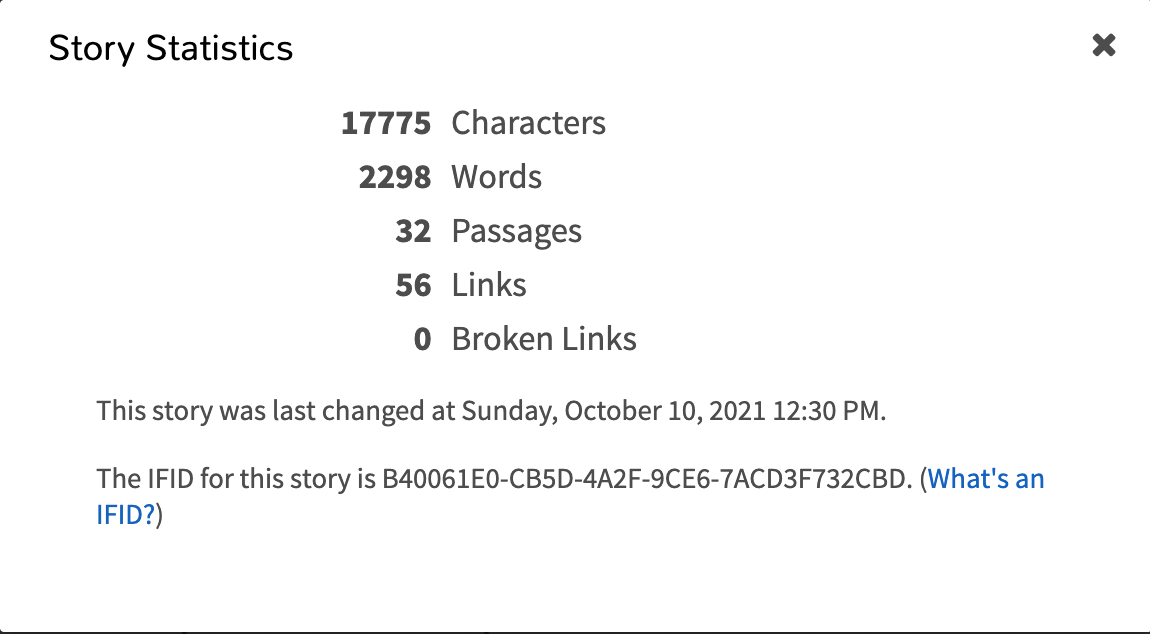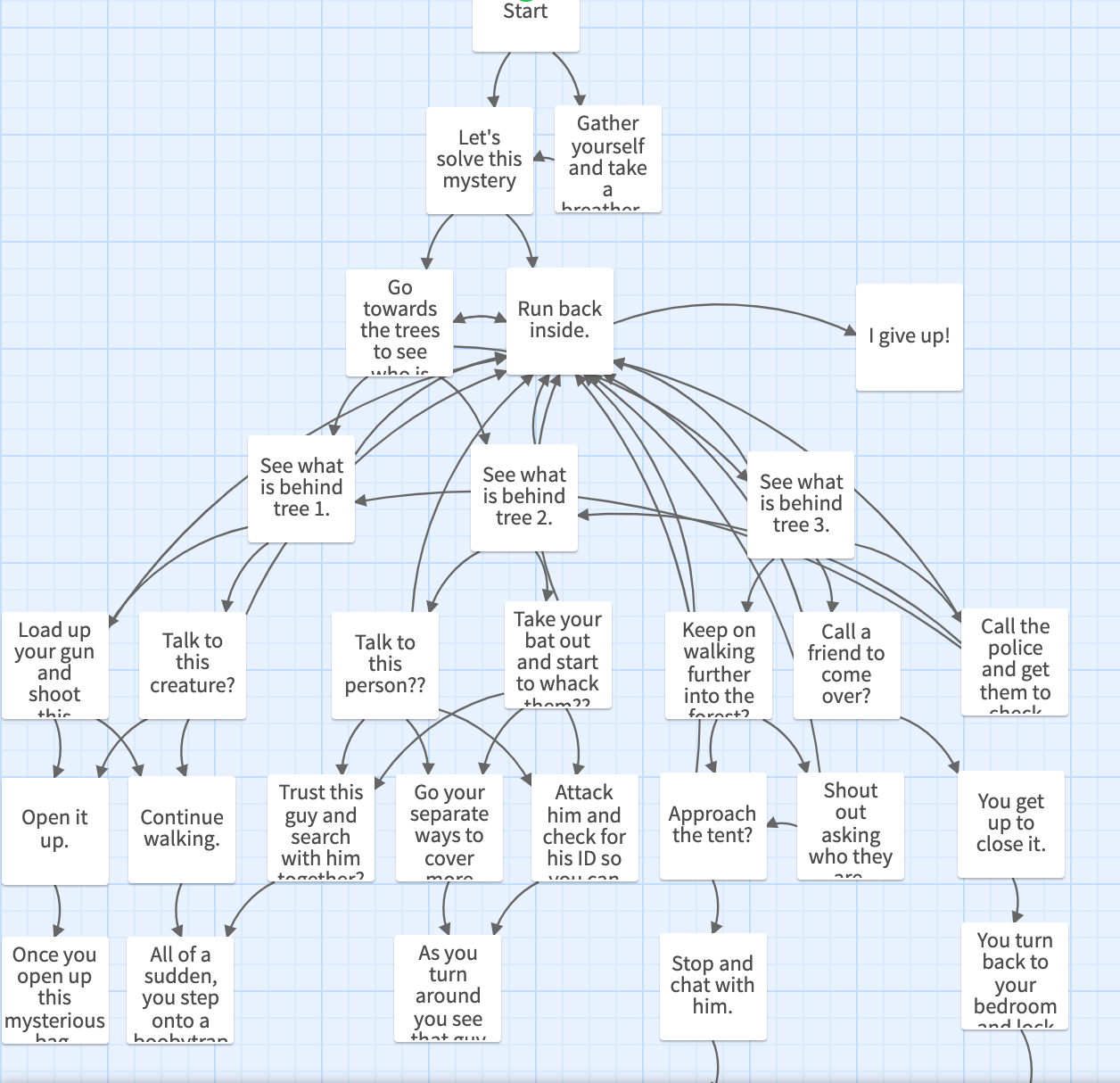If you click the Twine Project below, you will be able to download my Twine, called What Lurks in the Night?
What Lurks in the Night – Twine Project

Making this twine was tons of fun and I think I got carried away just a bit.
I decided to create a twine that was spooky and fitting for October and Halloween. Scary movies are one of my favourite genres to watch as I love to get scared every once in a while. Also, I think that horror films prepare you for what not to do in real life. I believe that the pictures create a visual for players to feel as if they are actually experiencing this in real life. The photos that were added to my Twine were collected from Pixabay and Shutterstock. Adding sound effects and background noise would have elevated this twine even more. There were many times that I went into my story and edited text to make sure it was just right. When I thought I was done, there would be something else that I would have to add which then added more pages. I had to make sure that everything flowed just right; that it was spooky, engaging, and challenging, as there is only one path that leads you to the right level and it is strictly by chance. Perhaps this was all a dream. Perhaps there was nothing out there at all except for Larry who was kicked out by his wife. The point is, we don’t really know what is around the corner and sometimes it works out and other times we are just playing by chance. Even though you DIE, you can still return to previous pages to try to find your way out. I also must add that YouTube helped me out a lot in figuring out the coding for images, the mechanisms of the text (movement and colour), and adding sound. For the amount of time I had in creating this Twine, I was unable to put in the sound effects and music as it is a lengthy process. As well, I started creating my Twine in Safari, resulting in the html not saving in proper format, therefore I had to learn how to convert my Twine story from Safari to Chrome without losing any data. I was so nervous I was going to do my work but YouTube saved the day once again.
I also wanted to share the story statistics as I found it interesting to see. As you can see, there are 17, 775 characters, 2298 words, 32 passages, 56 links, and 0 broken links (Yippie!).

Throughout my Twine story, the technological advancement of writing a story is seen as different actions may cause different outcomes. This reminds me of the movie called, The Butterfly Effect (2004) which showed the audience how the way in which one reacts to an encounter and scenario (aka: variables) can change the final outcome. The interactive ability that is built within this twine story shows how the text can create meaning. Also, the rules and instructions of this twine story can play a role in how stories are created online. With my story, there are many encounters where players have to make a choice even though they do not know what the future holds for them. The unknown creates suspense for the players and allows them to feel emotion while getting through this story, that ultimately they have created with their choices.
Twine uses the hypertext concept as it allows creators to make their story by linking the pages together. Twine allows there to be links from one page to another with easy skips and flows between different pages that lead to a preferred outcome. The creator is able to see the connection of links compared to the reader, however, Bolter (2001) states, the “links [between pages] constitute a path through a virtual space and the reader becomes a visitor or traveler in that space” which is a magical experience (p. 29). In the video by Wesch (2007), he shows us how information is shared, stored, critiqued, and created from shelves and drawers in the
library to scroll through information on the internet. Text has definitely changed from words in physical books written in such a linear fashion, as Bolter (2001) describes it as a “complete or closed verbal structure,” to a circular, more organically arrangement with the use of hyperlinks (p. 77). As humans, we rarely stay on a straight path, there are always obstacles, wrong turns, hazards, celebrations, and journeys that we encounter, making our life full of different shaped lines, turns, curves, circles, and u-turns. According to Bolter, (2001), he stated that Ted Nelson viewed hypertext like it was “natural to the mind,” which is how I also believe it to be (p. 42). Sometimes I feel like I have a hundred pages opened up in my mind, however, I always seem to circle back and reuse my thoughts that are stored in my head. Finally, Bolter (2001) proposed that using hypertext can allow players/readers to access all the text quickly in a way that a physical printed book is unable to do, therefore the hypertext allows the content to be flexible and interchangeable.

References
Bolter, J. (2001). Writing space: computers, hypertext, and the remediation of print. New York, NY: Routledge.
Wesch, M. (2007, October 12). Information R/evolution. [Video File]. YouTube. https://www.youtube.com/watch?v=-4CV05HyAbM
Hi Stephanie,
Your Twine story was a spooky and cool read. I was so interested in finding out what would happen next that I forgot to check my ammo, health and courage until the last two pages. My health quickly went from 100 to 0. I died, but at least I had fun before that happened.
I agree with you and Ted Nelson that hypertext is like the natural mind, because ideas flow from one to another and sometimes back again. I thought your description of your mind being open at a hundred pages was poignant. The type of wording I like to reread and go back to later on in the future.
I don’t agree with Bolter’s assertion that hyptertext allows people to access ideas faster than physical books. A beloved book will naturally open up to well-read pages. The memory used to remember different hypertext navigation paths can also remember page numbers or the physcial location of the approximate page.
Fantastic game, Stephanie! I love the sense of humour in your writing. Great to see the use of variables to include the mechanics of the ammo/health/courage stats. A very engaging and enjoyable game 🙂